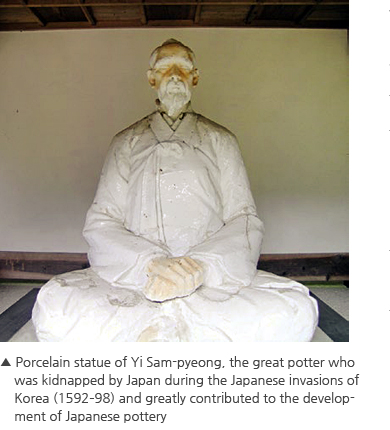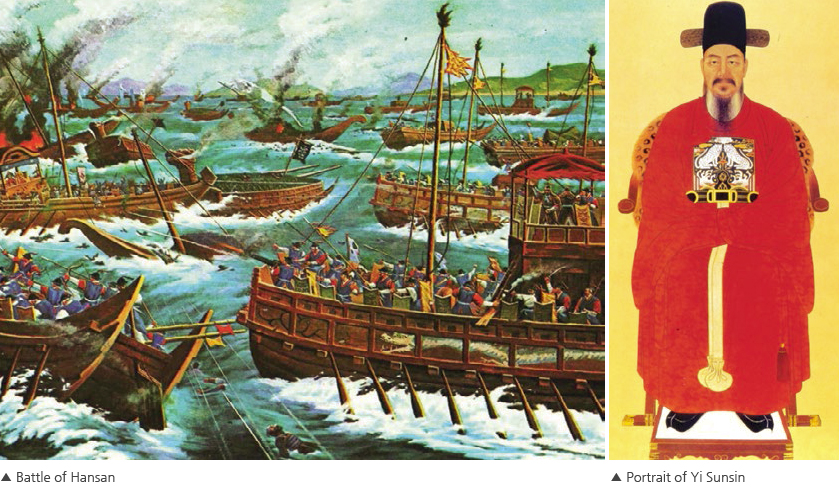Culture Focus
Korea in the World
History before 1945: Joseon Dynasty
 |
Joseon DynastyCommerce flourished in the yangban-centered Joseon society, although merchants and craftsmen were looked down upon. National defense was sometimes neglected by the rulers in a society where literary mastery was the most important gauge of competence. This meant that ultimately Joseon could not effectively respond to foreign aggressions.In 1592, Toyotomi Hideyoshi of Japan mounted an invasion of Joseon Dynasty. It eventually repelled the Japanese force but the seven-year-long, bloody Imjin War left Korea in ruins, with many cultural treasures either pillaged or destroyed. Japan also abducted many skilled Korean potters, who later contributed to the advancement of ceramic arts in Japan. In 1636, the Manchus, dissatisfied by the Korean court’s pro-Ming diplomacy, invaded Korea with a large army. After all-out resistance failed, Joseon King Injo surrendered to the Manchu emperor. |
Over the course of the next two centuries, the Joseon government made major attempts to rehabilitate the country. The government took reform measures to nurture agriculture and commerce. A series of tax reforms reduced the tax burden of tenant and smallholder farmers, and the introduction of new agricultural technologies greatly improved agricultural productivity. The development of free markets, trade, and the emergence of entrepreneurial merchants and economically independent artisans represented remarkable economic progress in Joseon society. These were significant, self-initiated steps toward modernization.
A new school of thought known as “Practical Learning” (Silhak) emerged. Scholars of this group pointed out the many ills facing society and sought to find solutions to them. Two kings—Yeongjo and Jeongjo in the 18th century—supported the scholarly efforts of Silhak and cultural development.
Korean envoys traveled to Beijing regularly, and they brought products of Western civilization such as maps and clocks back with them. Catholicism also reached Korea, in an unusual process where Koreans voluntarily embraced the new religion prior to the arrival of Western missionaries. The new religion slowly spread, and the newly converted Catholics built churches and carried out organized evangelical campaigns.
The late 19th century marked the high point of European power and aggressions, as the nations of Europe rushed to gobble up the last remaining unclaimed pieces of the world in a frenzy known as New Imperialism. Japan unilaterally claimed a “sphere of influence” that included Korea, Manchuria, and part of China, and launched a vigorous program of military aggression.
A new school of thought known as “Practical Learning” (Silhak) emerged. Scholars of this group pointed out the many ills facing society and sought to find solutions to them. Two kings—Yeongjo and Jeongjo in the 18th century—supported the scholarly efforts of Silhak and cultural development.
Korean envoys traveled to Beijing regularly, and they brought products of Western civilization such as maps and clocks back with them. Catholicism also reached Korea, in an unusual process where Koreans voluntarily embraced the new religion prior to the arrival of Western missionaries. The new religion slowly spread, and the newly converted Catholics built churches and carried out organized evangelical campaigns.
The late 19th century marked the high point of European power and aggressions, as the nations of Europe rushed to gobble up the last remaining unclaimed pieces of the world in a frenzy known as New Imperialism. Japan unilaterally claimed a “sphere of influence” that included Korea, Manchuria, and part of China, and launched a vigorous program of military aggression.

| Religion in Contemporary Korea |
|
It was not until the 17th century that Christianity was introduced to Korea, which was traditionally a nation of Buddhism and Confucianism. Books related to Catholicism were imported to Korea and studied in the 17th century, and the first believers appeared in the late 18th century. On the other hand, Protestantism was introduced by Presbyterian and Methodist missionaries in the late 19th century. Today, around 30 percent of South Koreans consider themselves to be Christians. Both Protestant and Catholic churches are more successful and influential than in most other Asian nations. Meanwhile, Buddhism experienced a revival throughout the 20th century and remains popular in modern South Korea, with about a sixth of its citizens being Buddhists. Korean Buddhism has even globalized, with over a hundred teaching-and-practice centers spread throughout every continent since the 1990s. Some Koreans still follow shamanism, the primitive religion with elements of animism and syncretism. Confucianism continues to influence social norms, especially the Korean work ethic, and traditional veneration ceremonies continue to be held nationwide. A variety of other religions are freely practiced in South Korea, including Islam. Modern South Korea is extraordinary in that a variety of religions, both foreign and indigenous, coexist in harmony. There is a respectful relationship among Protestant and Catholic churches, Buddhism, Won Buddhism, Confucianism, Cheondogyo, and Islam. |
Korea in the World
It is not easy to understand a foreign country in a short time. is a brief introduction of Korea for educators unfamiliar to Korea. The booklet collects and summarizes significant historical, cultural, and politico-economical traces of Korea. An essential material for educators who want to bring Korea in the textbook and to classroom.
It is not easy to understand a foreign country in a short time.

